How to Plant Bamboo: Sustainable Growth & Care Techniques
- April 5, 2024
- 0 comment
Bamboo, known for its rapid growth and distinctive aesthetic, is a popular choice for gardeners and landscapers seeking to add an exotic or tropical flair to their outdoor spaces. Belonging to the grass family, it’s an eco-friendly plant that’s both durable and versatile. This article provides a comprehensive guide on how to plant bamboo.
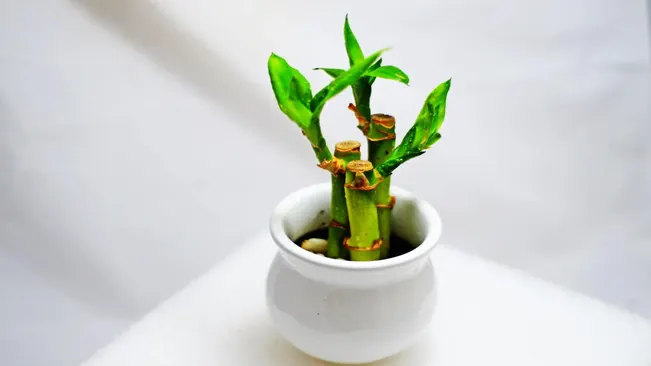
List on How To Plant Bamboo
- Choosing the Right Bamboo
- Preparing for Planting
- Planting Process
- Post-Planting Care
- Common Challenges
- Benefits of Bamboo
Choosing the Right Bamboo
When selecting bamboo for your garden or landscaping project, the two key considerations are the species type (clumping or running) and the specific climate and soil conditions of your location.
Species Selection
Clumping Bamboo
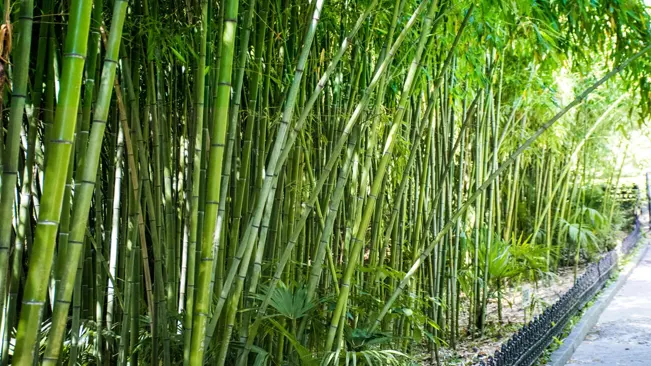
- Growth Habit: Clumping bamboo grows upright and expands outward slowly, forming tight clusters. This type is non-invasive, making it a preferred choice for residential gardens where control is important.
- Suitability: Ideal for smaller areas or where boundary control is necessary. It’s often used for privacy screens or ornamental purposes.
- Popular Varieties: Bambusa, Fargesia, and Thamnocalamus are common clumping bamboo genera.
Running Bamboo
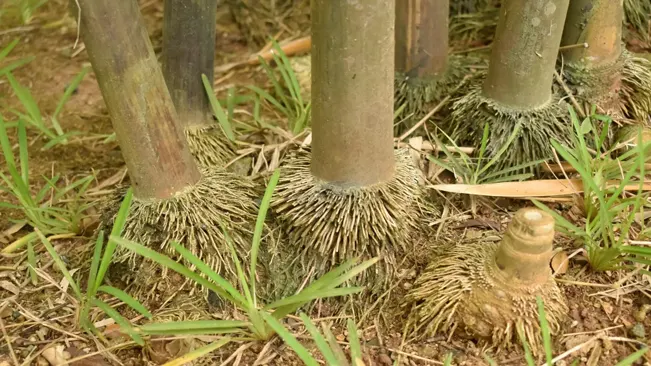
- Growth Habit: Running bamboo spreads quickly through underground rhizomes. It can cover large areas, making it suitable for creating dense screens or groves.
- Control Measures: If opting for running bamboo, installing a rhizome barrier is recommended to prevent it from becoming invasive.
- Popular Varieties: Phyllostachys and Sasa are well-known running bamboo genera.
Climate and Soil Conditions
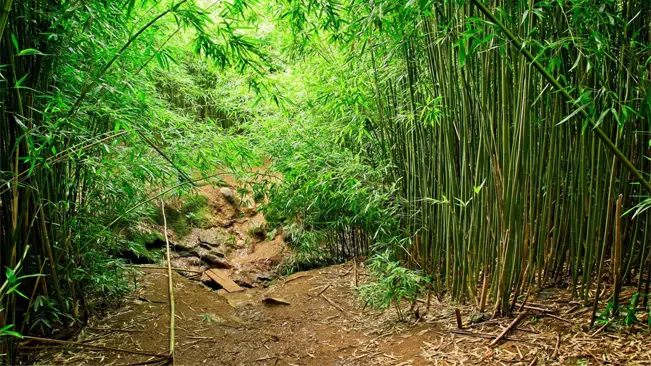
- Climate Adaptability
- Temperature Tolerance: Some bamboo species are more cold-hardy (like Phyllostachys nuda), suitable for cooler climates, while others (like Dendrocalamus) prefer warm, tropical environments.
- Sunlight Requirements: Most bamboos prefer full sun but can tolerate partial shade. The amount of sunlight can affect the growth rate and health of the plant.
- Soil Preferences
- Soil Type: Bamboos grow best in well-draining, fertile soil. They can thrive in a variety of soil types, but poorly-drained, waterlogged soil can lead to problems like root rot.
- Soil pH: While bamboo is not overly fussy about soil pH, slightly acidic to neutral soil is generally preferred. You can amend your soil with organic matter to improve its structure and fertility.
Preparing for Planting
Preparing adequately for planting bamboo is crucial for its successful growth and maintenance. Let’s delve into the two key aspects you mentioned – soil preparation and planting location:
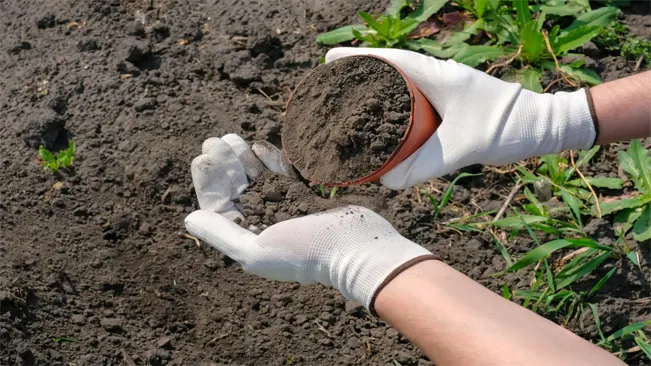
Soil Preparation
- Understanding Loamy Soil: Loamy soil is ideal for bamboo because it has a balanced mixture of sand, silt, and clay. This composition allows for good drainage while still retaining enough moisture and nutrients. Bamboo does not thrive in soils that are either too sandy or too clayey.
- Enhancing Soil Quality:
- Organic Matter: Incorporating organic matter such as compost or well-rotted manure into the soil can significantly improve its fertility and structure. This provides the bamboo with essential nutrients and enhances the soil’s ability to retain moisture without becoming waterlogged.
- pH Level: Bamboo prefers slightly acidic to neutral soil (pH around 6.0 to 6.5). If necessary, test your soil’s pH and adjust it accordingly using soil amendments.
- Drainage: Ensure good drainage to prevent waterlogging, which can cause root rot in bamboo. If your soil is compact or clayey, consider raising the planting bed or adding sand and organic matter to improve drainage.
- Pre-Planting Soil Preparation: Before planting, it’s advisable to work the soil well, breaking up any clumps and removing weeds. Mix in the organic matter evenly to create a hospitable environment for the bamboo roots to grow and spread.
Planting Location
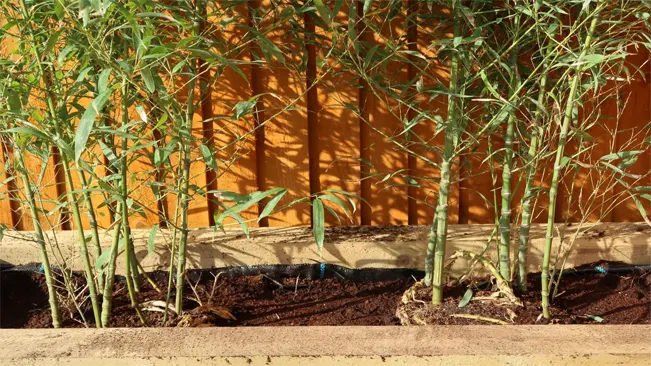
- Sunlight Requirements
- Most bamboo species prefer a location that receives full to partial sunlight. While some bamboo can tolerate shade, they generally grow taller and fuller in brighter conditions.
- Space Considerations
- Take into account the mature size of the bamboo. Provide enough space for it to grow both in height and width. The area should not be cramped or too close to buildings, as bamboo can be expansive.
- Running Bamboo Management
- Rhizome Barrier Installation: For running bamboo, a rhizome barrier is essential to control its spread. This barrier should be made of a durable material like thick plastic or metal and should be buried at least 2 to 3 feet deep around the planting area.
- Regular Maintenance: Even with a barrier, regularly check for and trim any rhizomes that attempt to cross the barrier. This helps prevent the bamboo from becoming invasive and encroaching on other areas of your garden.
- Wind and Privacy Considerations:
- Bamboo can provide excellent windbreaks and privacy screens. Planting it along property lines or in areas exposed to strong winds can be both functional and aesthetically pleasing.
Planting Process
When to Plant
- Planting bamboo in spring capitalizes on the growing season’s start. This timing allows the bamboo to establish itself with the aid of warmer temperatures and seasonal rains. The exact timing may vary depending on your local climate, but generally, it’s after the last frost when the soil begins to warm.
Planting Depth and Spacing
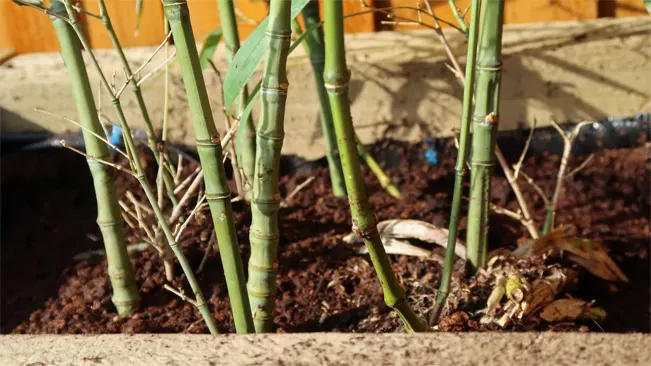
- Depth: The key is to plant bamboo at the same depth it was in its container. Planting too deep can suffocate the plant, while too shallow planting exposes roots to the elements.
- Spacing: This varies widely. For a dense screen or hedge, closer spacing (3-5 feet for smaller species, up to 10 feet for larger ones) is preferred. If you’re planting for an open grove look or if the species is particularly vigorous, increase the spacing.
Planting Procedure

- Preparation: Before placing the bamboo, loosen the soil at the bottom of the hole to facilitate root expansion.
- Placement: Carefully place the bamboo in the center of the hole, spreading the roots outwards. It’s important to ensure the plant is upright and at the correct depth.
- Backfilling: Fill the hole with soil, preferably mixed with compost or a planting mix to boost nutrient content. As you fill, gently tamp down the soil to eliminate air pockets, which can dry out roots and hinder growth.
- Mulching: After planting, apply a layer of mulch around the base of the bamboo. This helps retain moisture, suppress weeds, and regulate soil temperature.
Watering Regimen
- Initial Watering: Immediately after planting, water the bamboo thoroughly. This helps settle the soil and hydrates the roots.
- Regular Watering: Especially during its first growing season, bamboo requires consistent moisture. The goal is to keep the soil evenly moist but not soggy. Overwatering can be as harmful as under-watering, leading to root rot.
- Monitoring: Check the soil moisture regularly. The frequency of watering will depend on your climate, the season, and the bamboo species. Generally, young bamboos need more frequent watering than established ones.
Post-Planting Care
Mulching
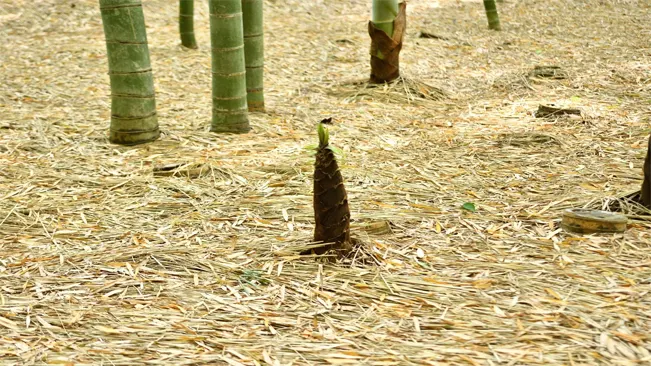
- Purpose of Mulching: Mulching is vital for retaining soil moisture, regulating soil temperature, and suppressing weed growth. It also adds organic matter to the soil as it decomposes, improving soil structure and fertility.
- How to Mulch: Spread a layer of organic mulch, like wood chips, straw, or compost, around the base of your bamboo plants. The layer should be about 2 to 4 inches thick. Be careful not to pile the mulch directly against the bamboo stalks, as this can lead to moisture accumulation and potential rot.
- When to Mulch: Apply mulch right after planting and refresh it once or twice a year, usually in the spring and/or fall. This replenishment is crucial as the mulch breaks down over time.
Fertilizing
- Need for Fertilization: Bamboo plants are vigorous growers and require nutrients to sustain their growth. Regular fertilization helps in providing these essential nutrients.
- Type of Fertilizer: A balanced, slow-release fertilizer, ideally one formulated for bamboo or similar plants, works best. The N-P-K (Nitrogen-Phosphorus-Potassium) ratio should be balanced, such as 10-10-10 or 20-20-20.
- How and When to Fertilize: Fertilize your bamboo in the spring as new growth starts, and you can do a lighter application in the summer. Avoid fertilizing late in the season as this can encourage new growth that might be damaged by cold weather.
Pruning
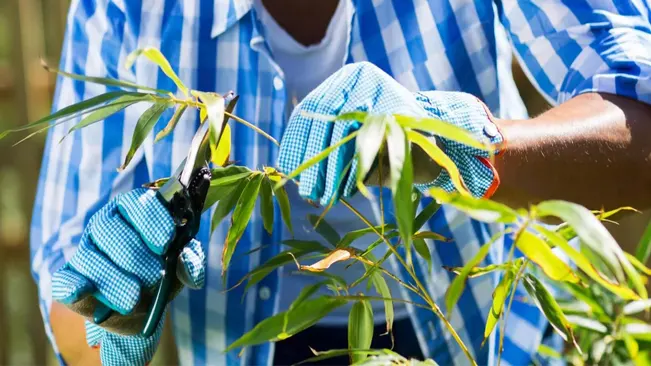
- Purpose of Pruning: Pruning helps in maintaining the desired shape and size of your bamboo, encouraging healthy growth, and removing any dead or diseased culms (bamboo stalks).
- Pruning Technique: Use sharp, clean pruning tools. Cut the culms close to the ground for thinning, and trim the lateral branches to shape the plant or control its size.
- Managing Running Bamboo: If you’ve planted running bamboo, regular pruning of the rhizomes (underground stems) is necessary to control its spread. You might need to dig around the bamboo and cut off any extending rhizomes.
- Best Time for Pruning: The best time to prune bamboo is during the dormant season, typically in late winter before new shoots emerge in the spring.
Common Challenges
Invasive Species
- Understanding Running Bamboo: Running bamboo spreads through underground stems called rhizomes. These rhizomes can travel far from the original plant, causing the bamboo to spread rapidly across an area.
- Installation of Rhizome Barriers: To control the spread of running bamboo, you can install rhizome barriers. These barriers are typically made of a tough, impermeable material like thick plastic, and they are buried around the bamboo planting area to a depth of about 2 to 3 feet.
- Regular Maintenance: Even with barriers, running bamboo requires regular maintenance. This involves monitoring the barrier’s edges and trimming any rhizomes that attempt to cross it.
- Choosing Clumping Bamboo: As an alternative, clumping bamboo varieties grow more slowly and expand in a tight cluster, rather than spreading widely. This makes them less invasive and easier to manage in a garden setting.
Pests and Diseases
- Bamboo Mites: These pests are small and can be challenging to detect. They usually cause speckled discoloration on the leaves. To control them, regularly clean debris from around your plants and consider using miticides if the infestation is severe.
- Root Rot: Overwatering or poorly draining soil can lead to root rot in bamboo. Symptoms include yellowing leaves and soft, black roots. Ensuring good soil drainage and avoiding overwatering are key preventative measures.
- Bamboo Blight: This is a fungal disease characterized by dark spots on leaves and stems. Good air circulation and avoiding overhead watering can help prevent this issue.
- Regular Inspection and Care: Regularly inspect your bamboo for signs of distress. Early detection of pests or disease is crucial for effective treatment and the overall health of your plants.
- Cultural Practices: Healthy cultural practices, such as proper spacing, adequate watering, and appropriate fertilization, can significantly reduce the likelihood of pest and disease problems.
Benefits of Bamboo
- Environmental Sustainability: Bamboo is one of the fastest-growing plants on Earth, making it a highly renewable resource. Its rapid growth rate means that it can be harvested frequently without causing damage to the ecosystem, unlike traditional timber.
- Carbon Sequestration: Bamboo absorbs carbon dioxide and releases oxygen into the atmosphere at a higher rate compared to many other plants. This makes it an excellent plant for improving air quality and combating climate change.
- Soil Erosion Control: The extensive root system of bamboo helps to bind soil and prevent erosion. This is particularly useful in areas prone to landslides or soil degradation.
- Biodiversity Preservation: Bamboo forests support a wide range of wildlife, providing habitat and food sources. This helps in maintaining and enhancing biodiversity.
- Versatile Material: Bamboo is incredibly strong and flexible, making it an ideal material for a variety of uses, from construction and furniture to clothing and utensils. Its natural properties make it a sustainable alternative to plastic and other non-biodegradable materials.
- Economic Opportunity: Bamboo cultivation can provide significant economic benefits, especially in rural areas. It can be used to create a variety of products, thus creating job opportunities and boosting local economies.
- Water Conservation: Bamboo requires less water to grow compared to other crops and trees. This makes it a more sustainable choice in areas with limited water resources.
- Air Purification: In addition to producing oxygen, bamboo can also absorb various harmful substances such as carbon monoxide, making it an excellent natural air purifier.
- Cultural and Aesthetic Value: Bamboo has a long history of being integrated into various cultures, especially in Asia. It is also used in landscaping due to its aesthetic appeal and can create a serene, peaceful environment.
- Renewable Energy Source: Bamboo can be used as a biomass for producing renewable energy, offering an eco-friendly alternative to fossil fuels.
Conclusion
Cultivating bamboo offers a unique blend of beauty and environmental benefits, transforming your garden into an aesthetically pleasing and ecologically responsible space. Adhering to the proper planting and maintenance guidelines ensures that your bamboo will flourish, providing long-lasting enhancement to your outdoor area. This sustainable choice not only elevates the visual appeal of your garden but also actively contributes to a greener, more sustainable world.
FAQs (Frequently Asked Questions)
- What is the best time of year to plant bamboo?
The ideal time to plant bamboo is in the spring. This season offers warmer temperatures and ample rainfall, which can help young bamboo plants establish themselves more easily. - How do I choose the right bamboo species for my garden?
Consider your climate, soil type, and the purpose of planting. There are two main types of bamboo – clumping and running. Clumping varieties are less invasive and easier to manage, while running bamboos spread faster and need more space and control. - How deep should I plant bamboo?
Bamboo should be planted at the same depth it was grown in its nursery pot. The hole should be twice as wide as the root ball to allow roots to spread easily. - Does bamboo need a lot of sunlight?
Most bamboo species prefer full sun or partial shade. However, some species may tolerate less light. It’s important to research the specific light requirements of the species you choose. - How often should I water newly planted bamboo?
Bamboo requires consistent moisture, especially during its first growing season. Water the plant deeply once or twice a week, depending on your climate and soil drainage. - Do I need to fertilize my bamboo plants?
Yes, bamboo benefits from fertilization. Use a balanced, slow-release fertilizer in the spring and possibly in the summer, following the product’s instructions. - How can I prevent bamboo from spreading uncontrollably?
For running bamboo types, installing a rhizome barrier around the planting area can help control its spread. Alternatively, you can choose clumping bamboo, which is less invasive. - How much space do I need between bamboo plants?
This depends on the bamboo species and your desired density. Generally, spacing can range from 3 to 10 feet. Closer spacing results in a denser screen or hedge. - Can bamboo be grown in pots?
Yes, bamboo can be grown in pots, especially the smaller or clumping varieties. Ensure the pot is large enough to accommodate the bamboo’s growth and has good drainage. - How do I deal with pests or diseases in bamboo?
Keep an eye out for signs of pests or diseases, such as discolored leaves or withered shoots. Most issues can be managed through proper care, such as ensuring adequate drainage to prevent root rot, or applying appropriate treatments for pests like bamboo mites.

Emma Hudson
Forestry AuthorEmma's experience in farming shapes her detailed guides on gardening and farming tools, providing practical, actionable advice grounded in real-world experience. Her work targets both newcomers and experienced farmers, aiming to enhance their practices with a mix of traditional wisdom and modern techniques. By making complex agricultural concepts accessible, Emma's guides serve as valuable tools for those navigating the challenges of contemporary farming, offering strategies for sustainable success.








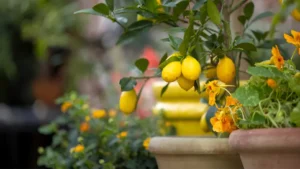




Leave your comment